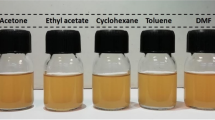Abstract
The objective of this research is to provide the first account of a simple preparation of surface fluorinated bulk cellulose nanocrystals and a characterization of their physical and chemical properties. The surface fluorinated, or polyfluorinated cellulose nanocrystals were first generated by reacting bulk cellulose with hydrochloric acid in an aqueous medium to yield cellulose nanocrystals that were subsequently purified and reacted with pentafluorobenzoyl chloride in presence of pyridine. The degree of substitution (out of a possible 3.0 hydroxyl groups/anhydroglucopyranose residue) of the polyfluorinated cellulose nanocrystals was 0.77. It was found that the dispersion of cellulose nanocrystals within an organic solvent was significantly improved following surface fluorination. Dynamic contact angle, FT-IR, NMR, TGA, DSC, XRD and XPS were used to confirm the fluorinated character of the reactant products. The polyfluorinated cellulose nanocrystals obtained and characterized demonstrated excellent hydrophobic and oleophobic properties to establish themselves as viable candidates in the consideration of a non-traditional and highly attractive conceptual paradigm for their inclusion as a nanofiller in a variety of low surface energy applications.







Similar content being viewed by others
References
Bondeson D, Mathew A, Oksman K (2006) Optimization of the isolation of nanocrystals from microcrystalline cellulose by acid hydrolysis. Cellulose 13:171–180
Deisenroth E, Jho C, Haniff M, Jennings J (1998) The designing of a new grease repellent fluorochemical for the paper industry. Surf Coat Int 81:440–447
Dufresne A (2010) Processing of polymer nanocomposites reinforced with polysaccharide. Molecules 15:4111–4128
Freire CSR, Silvestre AJD, Neto CP, Gandini A, Fardim P, Holmbom B (2006) Surface characterization by XPS contact angle measurements and ToF-SIMS of cellulose fibers partially esterified with fatty acids. J Colloid Interface Sci 301:205–209
George J, Bawa AS, Siddaramaiah (2010) Synthesis and characterization of bacterial cellulose nanocrystals and their PVA nanocomposites. Adv Mater Res 123:383–386
Gousse C, Chanzy H, Excoffier G, Soubeyrand L, Fleury E (2002) Stable suspensions of partially silylated cellulose whiskers dispersed in organic solvents. Polymer 43:2645–2651
Habibi Y, Lucia LA, Rojas OJ (2010) Cellulose nanocrystals: chemistry, self-assembly, and applications. Chem Rev 110:3479–3500
Ham-Pichavant F, Sebe G, Pardon P, Coma V (2005) Fat resistance properties of chitosan-based paper packaging for food applications. Carbohydr Polym 61:259–265
Jin G, Jeffrey M, Catchmark D, Douglas D, Archibald D, Edward QK (2010) Determination of sulfate esterification levels in cellulose nanocrystals by attenuated total reflectance—Fourier transform infrared spectroscopy. An ASABE Meeting Presentation, US, Paper No.: 1000008
Kissa E (2001) Fluorinated surfactants and repellents, revised and expanded, 2nd edn. Marcel Dekker, New York
Lirong T, Biao H, Nating Y, Tao L, Qilin L, Wenyi L, Xuerong C (2013) Organic solvent-free and efficient manufacture of functionalized cellulose nanocrystals via one-pot tandem reactions. Green Chem 15:2369–2373
Lu P, Hsieh YL (2010) Preparation and properties of cellulose nanocrystals: rods, spheres, and network. Carbohydr Polym 82:329–336
Lucia LA, Yui T, Sasai R, Takagi S, Takagi K, Yoshida H, Whitten DG, Inoue H (2003) Enhanced aggregation behavior of antimony (V) porphyrins in polyfluorinated surfactant/clay hybrid microenvironment. J Phys Chem A 107:3789–3797
Mohkami M, Talaeipour M (2011) Investigation of the chemical structure of carboxylated and carboxymethylated fibers from waste paper via XRD and FTIR analysis. BioResources 6:1988–2003
Poncin-Epaillard F, Legea G, Brosse JC (1992) Plasma modification of cellulose derivatives as biomaterials. J Appl Polym Sci 44:1513–1522
Rojas OJ, Macakova L, Blomberg E, Emmer A, Claesson PM (2002) Fluorosurfactant self-assembly at solid/liquid interfaces. Langmuir 18:8085–8095
Sadeghifar H, Filpponen I, Clarke PS, Brougham DF, Argyropoulos DS (2011) Production of cellulose nanocrystals using hydrobromic acid and click reaction on their surface. Mater Sci 46:7344–7355
Salam A, Pawlak JJ, Venditti AR, El-tahlaw K (2010) Synthesis and characterization of starch citrate–chitosan foam with superior water and saline absorbance properties. Biomacromolecules 11:1453–1459
Salam A, Pawlak JJ, Venditti AR, El-Tahlaw K (2011) Incorporation of carboxyl groups into xylan for improved absorbency. Cellulose 18:1033–1041
Samir MASA, Alloin F, Dufresne A (2005) A review of recent research into cellulosic whiskers, their properties and their application in nanocomposite field. Biomacromolecules 6:612–626
Schoenroth KG, Rengel GL (1967) Use of fluorochemicals to provide oil resistance etc. Pulp Pap Mag Can 8:478–480
Schwartz C (2011) Oil resistance utilizing fluorochemicals. Technical association of the pulp and paper industry, section sizing. Tappi Press, Chicago
Shi R, Zhang Z, Liu Q, Han Y, Zhang L, Chen D, Tian W (2007) Characterization of citric acid/glycerol co-plasticized thermoplastic starch prepared by melt blending. Carbohydr Polym 69:748–755
Vaca-Garcia C, Borredon ME, Gaseta A (2001) Determination of the degree of substitution (DS) of mixed cellulose esters by elemental analysis. Cellulose 8:225–231
Zhang Z, Wong CH (2002) Regioselective benzoylation of sugar mediate by excessive Bu2SnO: observation of temperature promoted migration. Tetrahedron 58:6513–6519
Zhang H, Wu J, Zhang J, He J (2005) 1-Allyl-3-methylimidazolium chloride room temperature ionic liquid: a new and powerful nonderivatizing solvent for cellulose. Macromolecules 38:8272–8277
Acknowledgments
We gratefully acknowledge partial support from the United Soybean Board (Smith, Bucklin & Associates, LLC) that allowed significant portions of this work to be completed. Lastly, LAL thanks Qilu University of Technology for the sabbatical that allowed parts of this work to be completed.
Author information
Authors and Affiliations
Corresponding author
Rights and permissions
About this article
Cite this article
Salam, A., Lucia, L.A. & Jameel, H. Fluorine-based surface decorated cellulose nanocrystals as potential hydrophobic and oleophobic materials. Cellulose 22, 397–406 (2015). https://doi.org/10.1007/s10570-014-0507-9
Received:
Accepted:
Published:
Issue Date:
DOI: https://doi.org/10.1007/s10570-014-0507-9




